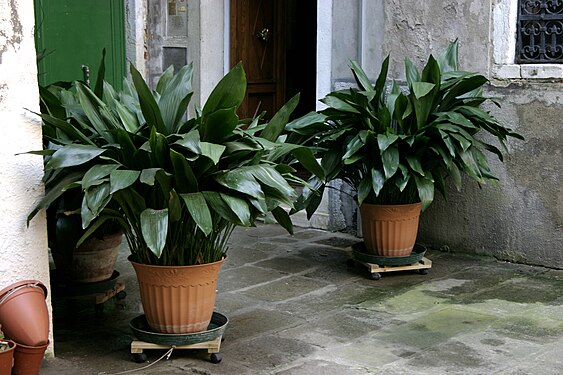Aspidistra elatior
| Habit | herbaceous
| |
|---|---|---|
| Height: | ⇕ | 1 m"m" can not be assigned to a declared number type with value 1. |
| Lifespan: | ⌛ | perennial |
| Origin: | ✈ | Japan |
| Exposure: | ☼ | part-sun, shade |
|---|---|---|
| Water: | ◍ | moderate, dry |
| Features: | ✓ | foliage, drought tolerant, houseplant |
|
elatior > |
Aspidistra elatior (Cast-iron Plant) is a rhizomatous perennial, native to Japan and widely cultivated as a houseplant. [1][2]
Aspidistra elatior is a stemless plant to 1 metre in height with dark green leaves.[2] Small, solitary purplish flowers may appear at the base of the plant in spring.[1]
Read about Aspidistra elatior in the Standard Cyclopedia of Horticulture
|
|---|
|
Aspidistra lurida, Ker-Gawl (A. elatior, Hort. A. punctata, Lindl.). Lvs. 15-20 in. long, stiff, evergreen, oblong-lanceolate, sharp-pointed, radical; blade narrowed into a channeled petiole a third of its length: fls. lurid purple, on short 1-fld. scapes; perianth segms. 8; stamens 8; stigma broadly shield-shaped, like a small mushroom. China. Var. variegate, Hort., has alternation of green and white stripes, no 2 Lvs. being exactly alike.—In Fla., the aspidistra makes beautiful dense specimens in unheated plant-sheds. It thrives in sunshine when growing along the edges of ditches and flowing water.
|
Cultivation
Aspidistra elatior is well-known in cultivation and has a reputation for withstanding neglect, giving rise to its common name of Cast-iron Plant.[2] It is tolerant of low light, low humidity, temperature fluctuation and irregular watering.[2] It is best situated in a position away from direct sun to avoid leaf bleaching.[2] Good drainage is also required for optimal growth and to avoid root rot.[2]
Propagation
- Do you have propagation info on this plant? Edit this section!
Pests and diseases
The species is not seriously troubled by insects, however mites and scale may cause occasional problems.[2] Its leaves and roots may be subject to browsing by hoofed mammals such as deer, as well as rodents and rabbits.
Varieties
A variegated form, A. elatior 'Variegata', is also cultivated.[2]
Gallery
If you have a photo of this plant, please upload it! Plus, there may be other photos available for you to add.
References
External links
- w:Aspidistra elatior. Some of the material on this page may be from Wikipedia, under the Creative Commons license.
- Aspidistra elatior QR Code (Size 50, 100, 200, 500)



